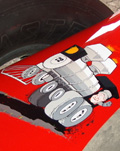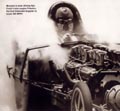Nye Franks Pulsator II
The PULSATOR II Top Fuel Dragster Story - as told to TwoToGo by George Klass
To understand the issues associated with the PULSATOR II it is first important to understand the successes of the FREIGHT TRAIN. The original FREIGHT TRAIN was inspired by NHRA's controversial nitro ban between 1957 and 1963. With all fuels except pump gasoline outlawed, Top Eliminator racers turned to multiple power plants to compensate for the absence of "horsepower in a can" at NHRA sanctioned drag strips.
John Peters and Nye Frank built the original FREIGHT TRAIN ( called the Quincy Automotive Special at the time ) in 1960, with a home-built chassis and a couple of 283 Chevy engines. The original combination was injected but soon a 6-71 supercharger was mounted on the front engine, derived off the crankshaft, and feeding both engines. It wasn't long after that each engine was fitted with its own 6-71, and mounted in the normal position on top of the engine and belt driven.
In 1963, the FREIGHT TRAIN, driven by Bob Muravez ( alias Floyd Lippencott Jr.) won the Top Gas Eliminator class at the NHRA Winternationals at Pomona, CA. starting it's meteoric climb to becoming the greatest and most well known gasoline powered dragster of all time.
The secret of the FREIGHT TRAIN's success was actually quite simple. The TRAIN had enough horsepower to be able to use the bigger Top Fuel dragster tires. The supercharged, gasoline powered single engine 392 Chryslers of that era used a smaller tire, out of necessity, to keep the the engines from bogging off the line. The TRAIN used the big meats and basically blew the Chryslers away.
With Top Gas victories and records securely in hand, Nye Frank decided to build a Top Fuel car using what he had learned while racing the Freight Train. Top Fuel drag racing at the time had some interesting problems, the biggest of which was how to keep a 1500 HP Chrysler, on 85% nitro, alive for more than just a few runs. Reliability was not the strong suit of the 354-392 Hemi. Nye reasoned that a Chevy engine, injected on straight nitro would be capable of putting out 800 - 900 HP, meaning of course that two Chevy's would be kicking out up to 1800 HP, more than enough to put the hurt on the Chryslers. And as to the reliability factor, the 1800 horsepower would be divided up over 16 rods and 16 pistons. The popular Junior Fuelers running at the time ( 300 cubic inches unsupercharged ) were very reliable with most racers running straight nitro right out of the can.
Nye built the chassis using similar specs as the new FREIGHT TRAIN. To give the new car ( named " THE
PULSATOR " ) some extra pizzazz, Nye built a beautiful fiberglass full body for the car, including a unique enclosed driver's cockpit. Naturally, the driver was Bob Muravez who rotated between driving the TRAIN and the PULSATOR.
The full body garnered a lot of attention, however, it was cumbersome to work on the car between rounds. The body was a two piece design, with a bottom half and a top half. To work on the engines, check the plugs, run the valves, etc., the entire top half of the body had to be removed from the car. More often than not, for convenience sake, the original PULSATOR ran without the body. Of course, the structure, tabs, and framework that held the body panels in place remained welded to the chassis. One night at Lions, Bob popped the chute after a run and the shroud lines somehow became entangled in this structure, lifting the back of the car completely off the ground, and high enough that when the car eventually returned to earth, the landing flattened both pans to the cranks. Not a good thing.
It was at this point that Nye decided to build a new PULSATOR, lighter and with a longer wheelbase and no body. This is also when I came into the picture. Nye and I had been roommates for a few years ( we were both working for Craig Breedlove on the Spirit of America Land Speed Record Project ). I had been following the trials and tribulations of the PULSATOR and we decided to form a three-person team with Nye, Bob Muravez and myself. To maintain the fraud, Floyd Lippencotte Jr. was still listed as the driver on our trailer, with Nye, Bob , and me listed as "the team".
Can two engines tied together produce double the horsepower? Why not? A V-8 can be thought of as two V-4's tied together at the crankshaft, or even as eight single cylinder engines tied together at the crank. Tying two V-8's together is not rocket science and has been done in drag racing numerous times with excellent results.
It's important to understand how the engines are coupled together on both the FREIGHT TRAIN and the PULSATOR. A heavy -duty sprocket ( like a sprocket on a motorcycle ) is bolted directly behind the flywheel of the front engine. A duplicate sprocket is bolted to the front crankshaft of the rear engine. When the engines are installed in the chassis, the two sprockets are about 1/2" apart. A dual-roller timing chain is wrapped around both sprockets. The neat thing about this kind of set-up is that the timing on both engines can be the same
( both firing #1 cylinder at the same time ) or depending on the number of teeth on the sprockets, at almost any other firing interval as deemed appropriate. In most cases, the engines are set -up to fire both #1 cylinders simultaneously.
PULSATOR II Photos
So, there you have it. The torque is transferred to the crankshaft, one cylinder at a time, moving front to rear toward the flywheel. And in the case of our set-up, the torque coming off the front engine is then transferred to the rear engine through the crankshaft coupler, and on to the rear flywheel. Very simple, right? This is probably the way most of the "In-Line" dual engine dragsters were set up. Works great, or at least it worked great on the FREIGHT TRAIN.
The thing you must remember is that the crankshaft coupling was EXACTLY the same on the PULSATOR II as it was on the TRAIN. So, what happened on the PULSATOR II?
Everytime PULSATOR II made a full power pass, the front engine ran clean and hard, while the rear engine ran like crap. Fouled plugs, hammered bearings, detonation and "black death" on the rear engine. Ok, the first thing to try was to swap engines ( since they were identical 327's stroked out to 364 cubic inches ). Now the rear engine was in the front and visa versa. The great running front engine, now in the rear, exhibited the same deadly symptoms. In effect, it wasn't the engine that was the problem, it was the location of the engine. Whichever engine happened to be in the rear, that engine reused to make power.
We installed both engines individually on Chet Herbert's dyno. Both put out about 900 HP each. Then, after we hooked them together, they put out about 950 HP total, barely more than each engine did by itself. What the heck was happening? This never happened with the TRAIN.
PULSATOR II
New PULSATOR Photo
After the initial hair pulling, some "experts" told us that it was possible that we were experiencing some form of electrical problem associated with the magnetos. This was defined for us as an electrical interference based on a "magnetic field" caused by the proximity of the two mags. Of course, the TRAIN never experienced this but then gasoline is easier to light off than nitro-methane. We mounted the front mag on the front engine off the front timing cover. This accomplished two things. It moved the mags further apart and it changed the "rotational field" by 90-degrees ( with one mag mounted horizontal and the other mag vertical ). This is clearly visible in the third PULSATOR II photo.
Unfortunately, there was no change whatsoever in either the performance or the "black death" on the rear engine. As long as we were in a "try anything mode", we even scrapped the mags and went with a couple of battery ignition systems. We tried the very powerful Grant distributors, but to no avail, no change, no improvement.
After that, we basically quit. Threw in the towel. It was not easy for Nye to walk away from this car but we had tried about everything we could think of, and everything that other engine builders could think of, Everyone agreed that there was some very strange phenomenon at work here.
The problem wasn't so much that the car wasn't working. The problem was that we were running the identical combination, installed with the identical configuration and the engine coupling system as the FREIGHT TRAIN was using. And to top that off, we had the same driver and one of our car owners was part of the original FREIGHT TRAIN team.
The differences between the two cars was minimal. The PULSATOR II was basically the FREIGHT TRAIN, without the superchargers and running on nitro.
Let's go back a minute. Remember when we were discussing how the engines were coupled together, and how the torque started at the leading cylinder of the front engine, traveled rearward to the flywheel of the front engine, then went through the coupler into the rear engine and then traveled back to the flywheel of the
second engine? This proved the key for us. The engines on the FREIGHT TRAIN each put out about 500 HP, or about 1000 HP together. The horsepower ( or torque ) from the front engine slid easily through the coupler and into the crankshaft of the rear engine. No problem. With the PULSATOR II, we were sticking 900 HP on the nose of the second engine. That's about a 400 HP difference. That extra 400 HP was apparently enough to rattle the hell out of the crankshaft, beating out the bearings and causing severe detonation. Nitro-methane is also a much more violent explosion. We didn't have the advantage of those big belt driven 6-71's on each engine. A roots type supercharger driven by a big rubber cog belt is a wonderful " crank dampner " it turns out.
New FREIGHT TRAIN Photos
All of this happened prior to the introduction of the 350 cubic inch Chevy small block. The 350 Chevy had a much stouter, beefier, and larger diameter crank. Had we had access to that engine instead of the 327's, maybe none of everything I described would have happened. Or, had we gone with the just released 396 cubic inch big block for the rear engine, none of this would have happened. Unfortunately for the PULSATOR II team, we had to use what was available at the time.
Of course, our issues stemmed from using the "in-line" dual engine combination. Had we relied on the "side by side" combinations, like Tommy Ivo, we may never have experienced these problems either. The torque of both engines would have been coupled at the flywheels. There would not have been a "front and rear engine".
We never ran the car again.
Last I heard, the chassis was hanging from the rafters in Bob Muravez's garage. I have no idea what happened to either of the engines, never asked and I don't want to know.
TwoToGo would like to thank George Klass for contributing this history of the PULSATOR II Twin, plus a little bonus PULSATOR and FREIGHT TRAIN history.
First Ten Twins I 4-6 cyl. Twins I Side by Side Twins I In-Line Twins ( 1950's to 1965 ) I In-Line Twins ( 1966 to Present ) Flathead Twins I Other Twins I Links I Contributors I Tributes: Tommy Ivo I Lefty and Chet I Chris Karamesines
Tribute Page
Twin Engine Drag Car Text History










